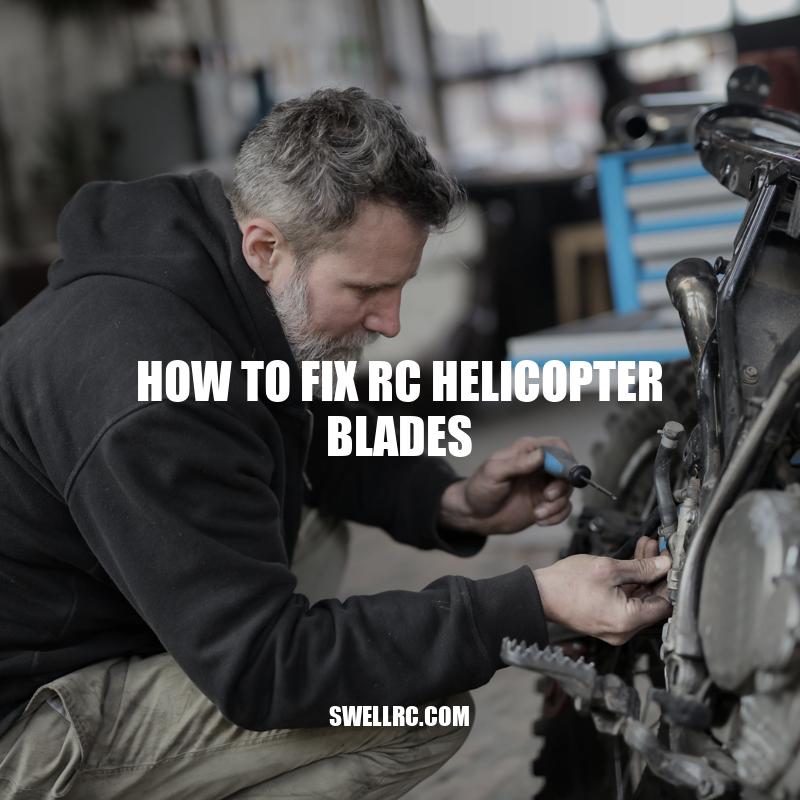How to Fix RC Helicopter Blades: A Step-by-Step Guide
RC helicopters are popular among hobbyists and enthusiasts who enjoy flying small aircraft. However, like any technology, RC helicopters can sometimes experience problems, and one of the most common is damaged or broken blades. Whether you’re a seasoned pro or a beginner, dealing with damaged blades can be frustrating, but it doesn’t have to be costly. With a little knowledge and the right tools, you can fix broken or damaged blades yourself. This guide provides step-by-step instructions on how to fix your RC helicopter blades. It doesn’t matter if you’re dealing with a minor crack or significant damage to the blades; you’ll learn how to diagnose the problem, gather the necessary tools and materials, and fix the blades. So, whether you’re looking to save some airtime or just want to understand how to fix your helicopter blades, this guide can help you tackle the challenge with confidence.
Diagnosing the problem
Before attempting to fix the blades, it’s essential to determine what the problem is. Here are some common issues that can cause blade damage:
- Crashes: Hard landings or collisions with obstacles can cause the blades to become damaged or broken.
- Wear and tear: Over time, blades can become worn, leading to cracks or other types of damage.
- Design flaws: Some RC helicopters may have design flaws that cause the blades to wear or become damaged more quickly than expected.
To identify the source of the damage, it’s essential to inspect the blades closely. Here are some tips that can help you diagnose the problem:
- Look for visible signs of damage, such as cracks, breaks, or deformations.
- Check for looseness in the blades, which can indicate a connection problem.
- Spin the blades by hand to check for wobbling or shaking, which can indicate misalignment or balance issues.
- Consider using a magnifying glass or other tools to get a closer look at the blades to identify small cracks or other types of damage.
If you’re having trouble diagnosing the problem or need replacement parts, there are several websites and online stores that specialize in RC helicopters and related equipment. These sites can be a helpful resource for finding replacement blades or getting advice from experienced hobbyists.
Why don’t helicopters have more blades?
Although helicopters generally have only two or four blades, some models can have up to eight blades. However, increasing the number of blades doesn’t necessarily mean better performance. Here are a few reasons why helicopters don’t have more blades:
- Increased noise and vibration
- Higher fuel consumption and maintenance costs
- Decreased speed and maneuverability
- Difficulties in controlling the aircraft
Overall, the number of blades on a helicopter is determined by careful considerations of performance, stability, and safety.
Gather your tools and materials
Once you’ve identified the source of the problem, it’s time to gather the necessary tools and materials to fix the blades. Here’s what you’ll need:
- Screwdriver
- Pliers
- Sandpaper
- Replacement blades
- Glue
It’s important to use the right tools and materials to ensure that the repair is performed correctly. If you’re not sure what tools or materials to use, consult the manufacturer’s instructions or check online forums or websites dedicated to RC helicopters.
It’s interesting to note that some RC helicopter enthusiasts prefer to build their own blades using carbon fiber or other materials. These custom blades can offer improved performance and durability but require specialized tools and experience to construct.
There are several websites and online stores that specialize in RC helicopter parts and accessories, including replacement blades. Some popular sites include HorizonHobby.com, HeliDirect.com, and RCPlanet.com. These sites offer a wide range of options, as well as helpful product reviews and customer support.
How do you maintain your tools and materials?
Maintaining your tools and materials is crucial for their longevity and efficiency. Here are some tips:
- Clean tools and equipment after each use
- Store them properly in a dry and secure place
- Sharpen cutting tools regularly
- Oil moving parts to prevent rust and friction
- Inspect materials for damage and replace if necessary
By following these simple steps, you can ensure that your tools and materials remain in good condition and last longer.
Removing and replacing damaged blades
Once you have the necessary tools and materials, it’s time to remove the damaged blades and install new ones.
Steps to remove the damaged blades:
- Locate the screws or bolts holding the blades in place.
- Use a screwdriver or pliers to remove the screws/bolts.
- Gently remove the damaged blades from the helicopter.
Steps to install a new blade:
- Make sure the new blade is the correct size and shape for your specific helicopter model.
- Apply a thin layer of glue to the blade root.
- Gently slide the blade into place, aligning the screw/bolt holes with the mounting base.
- Secure the blade with screws or bolts and tighten them just enough so that the blade is firmly in place but not too tight.
- Repeat these steps for the other blade.
It’s important to follow the manufacturer’s instructions when installing new blades to ensure they are installed correctly. Failure to do so can result in further damage or even accidents.
If you need to purchase new blades, check online stores or hobby shops. Some popular online stores for RC helicopter parts include Amazon, eBay, or helidirect.com. Be sure to choose a reputable seller or store to ensure the quality of the product.
How do you clean helicopter blades?
Cleaning helicopter blades is an essential maintenance task to keep them in good condition. Here’s how to do it:
- Start by removing any debris or loose dirt with a soft-bristled brush.
- Apply a cleaning solution or degreaser to the blades, following the manufacturer’s instructions.
- Rinse the blades thoroughly with water, making sure to remove all cleaning solution residues.
- Dry the blades with a clean, lint-free cloth or allow them to air-dry.
It is important to note that some cleaning solutions or degreasers may not be suitable for certain types of helicopter blades. Always check the manufacturer’s recommendations before use.
If you are looking for high-quality cleaning products specifically designed for helicopter maintenance, check out websites like SkyGeek or Aircraft Spruce.
Realigning blades
If you notice that the blades are misaligned or not spinning properly after installing new ones, they may need realignment.
Steps to realign blades:
- Detach one blade from its mounting base, leaving the other in place.
- Rotate the remaining blade 180 degrees so that it’s upside down and facing the opposite side of the helicopter.
- Compare the height of the two blades, looking for any noticeable differences.
- Place a small piece of tape on the blade that’s lower, and sand it down until they are even.
- Repeat these steps for the other blade.
It’s important to follow the manufacturer’s instructions when realigning the blades. Remember to be patient and take your time during this process.
If you need additional assistance, there are numerous online forums and videos that offer guidance on fixing and maintaining RC helicopters. Some popular forums include RCGroups.com and Helifreak.com. You can also find instructional videos on YouTube or Vimeo. Additionally, some helicopter manufacturers and hobby shops offer customer service or technical support to help you troubleshoot any issues you may encounter.
How do you align razor blades?
To align razor blades, follow these quick steps:
- Remove the razor blade from the razor handle.
- Place the blade onto a flat surface.
- Check the edges of the blade to see if it appears bent or warped. If so, discard the blade.
- Align the blade by gently easing it back into a straight position. Use a soft cloth or gloves to avoid cutting yourself.
- Reinsert the blade onto the razor handle and gently tighten the handle.
For more information on shaving techniques and products, visit websites such as Gilette and Harry’s.
Sanding and balancing the blades
Even new blades may not be perfectly balanced, which can affect the performance of your RC helicopter. Sanding and balancing your blades can improve their performance and prevent future damage.
Steps to sand and balance blades:
- Start by sanding the heavier blade, using sandpaper to remove small amounts of material at a time.
- Avoid sanding the blade too much, as this can make it too light and unstable.
- Weigh both blades on a small scale to see if there is any difference.
- If one blade is significantly lighter, you can add a small weight to it, such as a piece of tape or clay, until the weight is balanced.
- Recheck the weight to ensure it’s balanced and adjust as necessary.
Remember, achieving balance takes practice, and it’s important to take your time during the process.
If you’re unsure about sanding and balancing your blades or have any other questions or concerns about fixing your RC helicopter blades, there are many resources available online. Some popular forums include RCGroups.com and Helifreak.com. Additionally, some manufacturers and hobby shops offer customer service or technical support to help you troubleshoot any issues you may encounter.
Conclusion
In conclusion, fixing RC helicopter blades can seem daunting, but it’s a skill that can save you time, money, and the headache of having to replace your entire helicopter. Remember to diagnose the problem, gather your tools and materials, remove and replace damaged blades, realign the blades, and sand and balance the blades.
While it may take some trial and error, the sense of satisfaction that comes with fixing your own RC helicopter blades is well worth the effort. Just be sure to take your time and work methodically through the steps.
If you’re still unsure about how to fix your RC helicopter blades, remember that there are many resources available to help, including online forums and manufacturer customer service. And if you’re in the market for replacement blades or other parts, be sure to do your research and choose a reputable supplier to ensure that you get the best quality for your money.
With these tips in mind, you should now feel confident in your ability to fix your RC helicopter blades and get back to enjoying the fun of flying your helicopter.



